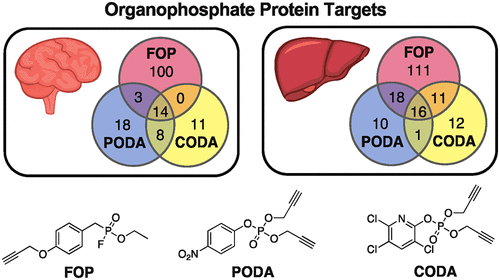当前位置:
X-MOL 学术
›
Chem. Res. Toxicol.
›
论文详情
Our official English website, www.x-mol.net, welcomes your
feedback! (Note: you will need to create a separate account there.)
Structure Dependent Determination of Organophosphate Targets in Mammalian Tissues Using Activity-Based Protein Profiling.
Chemical Research in Toxicology ( IF 3.7 ) Pub Date : 2020-01-10 , DOI: 10.1021/acs.chemrestox.9b00344 Vivian S Lin 1 , Regan F Volk 1 , Adrian J DeLeon 1 , Lindsey N Anderson 1 , Samuel O Purvine 2 , Anil K Shukla 2 , Hans C Bernstein 1, 3, 4 , Jordan N Smith 1 , Aaron T Wright 1, 5
Chemical Research in Toxicology ( IF 3.7 ) Pub Date : 2020-01-10 , DOI: 10.1021/acs.chemrestox.9b00344 Vivian S Lin 1 , Regan F Volk 1 , Adrian J DeLeon 1 , Lindsey N Anderson 1 , Samuel O Purvine 2 , Anil K Shukla 2 , Hans C Bernstein 1, 3, 4 , Jordan N Smith 1 , Aaron T Wright 1, 5
Affiliation

|
Acute and chronic exposures to organophosphates (OPs), including agricultural pesticides, industrial chemicals, and chemical warfare agents, remain a significant worldwide health risk. The mechanisms by which OPs alter development and cognition in exposed individuals remain poorly understood, in part due to the large number of structurally diverse OPs and the wide range of affected proteins and signaling pathways. To investigate the influence of structure on OP targets in mammalian systems, we have developed a series of probes for activity-based protein profiling (ABPP) featuring two distinct reactive groups that mimic OP chemical reactivity. FOP features a fluorophosphonate moiety, and PODA and CODA utilize a dialkynyl phosphate ester; both reactive group types target serine hydrolase activity. As the oxon represents the highly reactive and toxic functional group of many OPs, the new probes described herein enhance our understanding of tissue-specific reactivity of OPs. Chemoproteomic analysis of mouse tissues treated with the probes revealed divergent protein profiles, demonstrating the influence of probe structure on protein targeting. These targets also vary in sensitivity toward different OPs. The simultaneous use of multiple probes in ABPP experiments may therefore offer more comprehensive coverage of OP targets; FOP consistently labeled more targets in both brain and liver than PODA or CODA, suggesting the dialkyne warhead is more selective for enzymes in major signaling pathways than the more reactive fluorophosphonate warhead. Additionally, the probes can be used to assess reactivation of OP-inhibited enzymes by N-oximes and may serve as diagnostic tools for screening of therapeutic candidates in a panel of protein targets. These applications will help clarify the short- and long-term effects of OP toxicity beyond acetylcholinesterase inhibition, investigate potential points of convergence for broad spectrum therapeutic development, and support future efforts to screen candidate molecules for efficacy in various model systems.
中文翻译:

使用基于活性的蛋白质分析对哺乳动物组织中的有机磷酸盐靶标进行结构依赖性测定。
急性和慢性接触有机磷酸盐 (OPs),包括农业杀虫剂、工业化学品和化学战剂,仍然是一个重大的全球健康风险。OPs 改变暴露个体发育和认知的机制仍然知之甚少,部分原因是大量结构多样的 OPs 以及广泛的受影响蛋白质和信号通路。为了研究哺乳动物系统中结构对 OP 靶标的影响,我们开发了一系列用于基于活性的蛋白质分析 (ABPP) 的探针,该探针具有两个不同的反应基团,可模拟 OP 化学反应性。FOP 具有氟膦酸酯部分,PODA 和 CODA 使用磷酸二炔酯;两种反应基团类型都以丝氨酸水解酶活性为目标。由于 oxon 代表了许多 OP 的高反应性和毒性官能团,因此本文描述的新探针增强了我们对 OP 的组织特异性反应性的理解。用探针处理的小鼠组织的化学蛋白质组学分析揭示了不同的蛋白质谱,证明了探针结构对蛋白质靶向的影响。这些目标对不同 OP 的敏感性也不同。因此,在 ABPP 实验中同时使用多个探针可以提供更全面的 OP 目标覆盖;与 PODA 或 CODA 相比,FOP 始终在大脑和肝脏中标记更多的目标,这表明二炔弹头对主要信号通路中的酶的选择性高于反应性更强的氟膦酸盐弹头。此外,该探针可用于评估 N-肟对 OP 抑制酶的再激活,并可用作在一组蛋白质靶标中筛选治疗候选物的诊断工具。这些应用将有助于阐明 OP 毒性在乙酰胆碱酯酶抑制之外的短期和长期影响,研究广谱治疗发展的潜在收敛点,并支持未来筛选候选分子在各种模型系统中的功效的努力。
更新日期:2020-01-10
中文翻译:

使用基于活性的蛋白质分析对哺乳动物组织中的有机磷酸盐靶标进行结构依赖性测定。
急性和慢性接触有机磷酸盐 (OPs),包括农业杀虫剂、工业化学品和化学战剂,仍然是一个重大的全球健康风险。OPs 改变暴露个体发育和认知的机制仍然知之甚少,部分原因是大量结构多样的 OPs 以及广泛的受影响蛋白质和信号通路。为了研究哺乳动物系统中结构对 OP 靶标的影响,我们开发了一系列用于基于活性的蛋白质分析 (ABPP) 的探针,该探针具有两个不同的反应基团,可模拟 OP 化学反应性。FOP 具有氟膦酸酯部分,PODA 和 CODA 使用磷酸二炔酯;两种反应基团类型都以丝氨酸水解酶活性为目标。由于 oxon 代表了许多 OP 的高反应性和毒性官能团,因此本文描述的新探针增强了我们对 OP 的组织特异性反应性的理解。用探针处理的小鼠组织的化学蛋白质组学分析揭示了不同的蛋白质谱,证明了探针结构对蛋白质靶向的影响。这些目标对不同 OP 的敏感性也不同。因此,在 ABPP 实验中同时使用多个探针可以提供更全面的 OP 目标覆盖;与 PODA 或 CODA 相比,FOP 始终在大脑和肝脏中标记更多的目标,这表明二炔弹头对主要信号通路中的酶的选择性高于反应性更强的氟膦酸盐弹头。此外,该探针可用于评估 N-肟对 OP 抑制酶的再激活,并可用作在一组蛋白质靶标中筛选治疗候选物的诊断工具。这些应用将有助于阐明 OP 毒性在乙酰胆碱酯酶抑制之外的短期和长期影响,研究广谱治疗发展的潜在收敛点,并支持未来筛选候选分子在各种模型系统中的功效的努力。











































 京公网安备 11010802027423号
京公网安备 11010802027423号